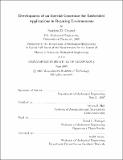Development of an inertial generator for embedded applications in rotating environments
Author(s)
Conrad, Stephen D. (Stephen David)
DownloadFull printable version (2.600Mb)
Other Contributors
Massachusetts Institute of Technology. Dept. of Mechanical Engineering.
Advisor
Steven R. Hall.
Terms of use
Metadata
Show full item recordAbstract
Inertial generators are devices that generate electrical energy from their inertial motion, and have only one mechanical connection with their surroundings. This makes them suitable power sources for embedded systems operating in environments that experience some inertial excitation. Typical inertial generators are designed to generate electricity from linear vibrations, and are often termed vibrational energy harvesters. Traditional sprung mass vibrational energy harvesters must be tuned to achieve resonance at a specific frequency, and perform poorly when the excitation does not fall within a narrow band around this natural frequency. In this thesis, a novel inertial generator is proposed that is specifically designed to take advantage of the unique inertial loads experienced by a system embedded within a large scale rotating part with a horizontal axis of rotation, such as the propeller of a large ship. The design process begins with the identification of the inertial path and then proceeds with the development of a device that takes advantage of the unique inertial loads experienced along that path. The device is designed to achieve resonance at any steady state rotation rate, without any active forms of actuation. This is achieved by utilizing centrifugal forces to produce a natural frequency that tracks the excitation frequency. Experimental results from full-scale spin testing verify that the device has a monotonically increasing power output with increasing frequency. This result contrasts sharply with the frequency response of a traditional sprung mass vibrational energy harvester, which typically has a single peak at the resonant frequency. Experimental results are also presented showing that the device can successfully deliver a charging current to a battery over a wide range of operating speeds.
Description
Thesis (S.M.)--Massachusetts Institute of Technology, Dept. of Mechanical Engineering, 2007. This electronic version was submitted by the student author. The certified thesis is available in the Institute Archives and Special Collections. Includes bibliographical references (p. 177-179).
Date issued
2007Department
Massachusetts Institute of Technology. Department of Mechanical EngineeringPublisher
Massachusetts Institute of Technology
Keywords
Mechanical Engineering.